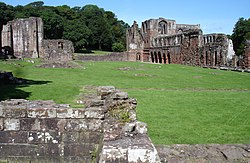St Mary's Abbey, Furness

The abbey in August 2007
|
|
| Monastery information | |
|---|---|
| Full name | Furness Abbey |
| Other names | St. Mary of Furness |
| Order | Cistercian |
| Established | 1123 |
| Disestablished | 1537 |
| Mother house | Congregation of Savigny |
| Controlled churches |
Byland Abbey Calder Abbey Inch Abbey Rushen Abbey Swineshead Abbey |
| People | |
| Founder(s) | Stephen, Count of Blois |
| Site | |
| Location | The Vale of Nightshade, Newbarns, Barrow-in-Furness, Cumbria, England |
| Public access | Yes ( |
Furness Abbey, or St. Mary of Furness is a former monastery located in the northern outskirts of Barrow-in-Furness, Cumbria, England. The abbey dates back to 1123 and was once the second-wealthiest and most powerful Cistercian monastery in the country, behind only Fountains Abbey in North Yorkshire.
Founded in 1123 by Stephen, Count of Boulogne, it was built originally for the Order of Savigny. Located in the 'Vale of Nightshade', south of Dalton-in-Furness, the abbey is built entirely out of local sandstone. It passed in 1147 to the Cistercians, who gradually enlarged and rebuilt the original ornate church. The majority of the current ruins date from the 12th and 13th centuries. By the 15th century, it had been completely re-modelled and had become the second richest and most powerful - as well as one of the grandest - Cistercian Abbeys in England, behind Fountains Abbey. The gothic-style monastery and its adjacent structures cover an expansive area of land and reach a maximum height of 40 metres (131 ft) above ground level.
The monks of the abbey were large landowners, and the most powerful body in what was then a remote border territory. In particular, they were heavily influential on the Isle of Man. One of the kings of Mann and the Isles is buried at the abbey, as are many of the Bishops of Sodor and Man. Rushen Abbey on the Isle was built on land owned by the monks. They also owned mines on the island, and built Piel Castle to control trade between the Furness Peninsula and the Isle of Man. Being about 70 miles down the coast from Scotland, the monks occasionally found themselves in between the regularly warring Scots and English. When Robert the Bruce invaded England, during The Great Raid of 1322, the abbot paid to lodge and support him, rather than risk losing the wealth and power of the abbey.
...
Wikipedia
